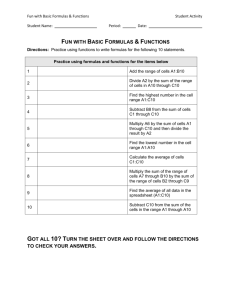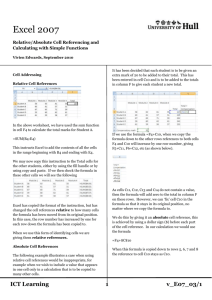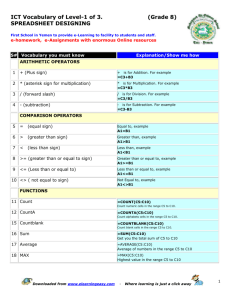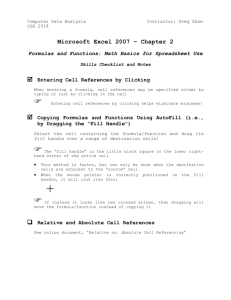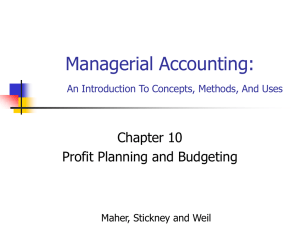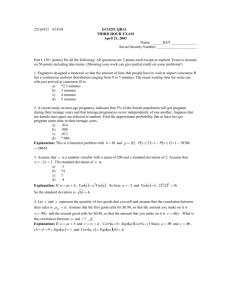Chapter 10, Corporate Text
advertisement
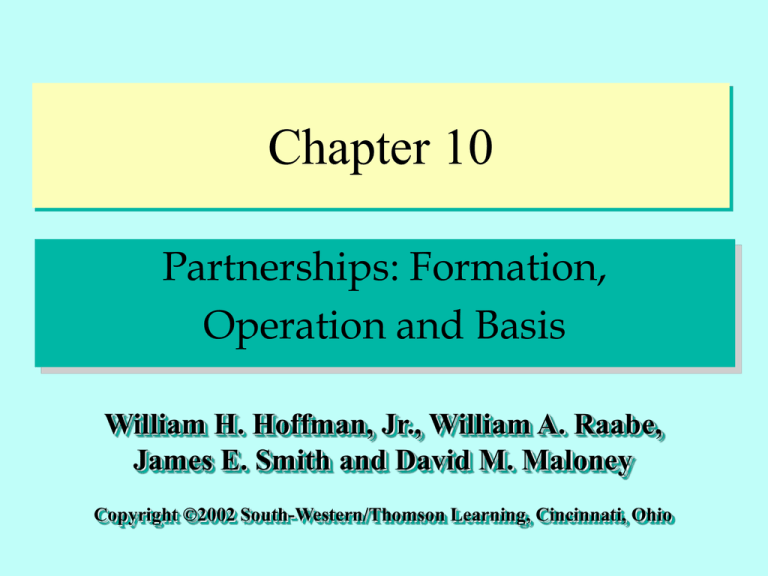
Chapter 10 Partnerships: Formation, Operation and Basis William H. Hoffman, Jr., William A. Raabe, James E. Smith and David M. Maloney Copyright ©2002 South-Western/Thomson Learning, Cincinnati, Ohio Partnership Definition • An association of two or more persons to carry on a trade or business – Contribute money, property, labor – Expect to share in profit and losses • For tax purposes, includes: – – – – Syndicate Group Pool Joint venture, etc C10 - 2 Entities Taxed As Partnerships (slide 1 of 4) • General partnership – Consists of at least 2 partners – Partners are jointly and severally liable • Creditors can collect from both partnership and partners’ personal assets • General partner’s assets are at risk for malpractice of other partners even though not personally involved C10 - 3 Entities Taxed As Partnerships (slide 2 of 4) • Limited liability partnership (LLP) – An LLP partner is not liable for malpractice committed by other partners – Popular organizational form for large accounting firms C10 - 4 Entities Taxed As Partnerships (slide 3 of 4) • Limited partnership – Has at least one general partner • One or more limited partners – Only general partner(s) are liable to creditors • Limited partners’ loss is limited to equity investment C10 - 5 Entities Taxed As Partnerships (slide 4 of 4) • Limited liability company (LLC) – Combines the corporate benefit of limited liability with benefits of partnership taxation • Unlike corporations, income is subject to tax only once • Special allocations of income, losses, and cash flow are available – Owners are “members”, not partners, but if properly structured will receive partnership tax treatment C10 - 6 “Check-The-Box” Regs (slide 1 of 2) • Allows most unincorporated entities to select their federal tax status – If 2 or more owners, can choose to be treated as: • Partnership, or • Corporation – Permits some flexibility • Not all entities have a choice • e.g., New publicly traded partnerships must be taxed as corporations C10 - 7 “Check-The-Box” Regs (slide 2 of 2) • Some entities can be excluded from partnership treatment if organized for: – Investment (not active trade or business) – Joint production, extraction, or use of property – Underwriting, selling, or distributing a specific security • Owners simply report their share of operations on their own tax return C10 - 8 Partnership Taxation (slide 1 of 3) • Partnership is not a taxable entity – Flow through entity • Income taxed to owners, not entity • Partners report their share of partnership income or loss on their own tax return C10 - 9 Partnership Taxation (slide 2 of 3) • Generally, the calculation of partnership income is a 2-step approach Step 1: Net ordinary income and expenses related to the trade or business of the partnership Step 2: Segregate and report separately some partnership items – If an item of income, expense, gain or loss might affect any 2 partners’ tax liabilities differently, it is separately stated – e.g., Charitable contributions C10 - 10 Partnership Taxation (slide 3 of 3) • Electing large partnerships can net some items that would otherwise be separately stated – Must have at least 100 partners and elect simplified reporting procedures – Report no more than 16 separately stated items • e.g., Net short-term and long-term capital gains and losses at partnership level and report the net amount to partners C10 - 11 Partnership Reporting • Partnership files Form 1065 – Includes Schedule K which accumulates the information to be reported to partners • Provides ordinary income and separately stated items in total – Each partner (and the IRS) receives a Schedule K-1 for each partner • Reports each partner’s share of income, expense, gain, and loss C10 - 12 Partner’s Ownership Interest • Each owner normally has a: – Capital interest • Measured by capital sharing ratio – Partner’s percentage ownership of capital – Profits(loss) interest • Partner’s % allocation of partnership ordinary income (loss) and separately stated items • Certain items may be “specially allocated” – Specified in the partnership agreement C10 - 13 Basis Issues (slide 1 of 4) • Each partner has a basis in their partnership interest – Partner’s basis is adjusted for income and losses that flow through • This ensures that partnership income is only taxed once C10 - 14 Basis Issues (slide 2 of 4) • Partner’s basis is important: – Establishes deductibility of partnership losses – Determines tax treatment of partnership distributions C10 - 15 Basis Issues (slide 3 of 4) • Partner’s basis is important (cont’d): – Affects calculation of gain or loss on sale or disposition of partnership interest • Partner’s capital account balance is usually not a good measure of a partner’s adjusted basis in a partnership interest for several reasons • e.g., Basis includes partner’s share of partnership liabilities; Capital account does not • There is a difference in a partner’s inside basis and outside basis C10 - 16 Basis Issues (slide 4 of 4) Outside Basis Partner’s basis in partnership interest Inside Basis Partner’s basis in share of partnership assets General rule: when partnership is formed, inside basis = outside basis C10 - 17 Conceptual Basis For Partnership Taxation (slide 1 of 2) • Involves 2 legal concepts: – Aggregate (or conduit) concept - Treats partnership as a channel with income, expense, gains, etc. flowing through to partners • Concept is reflected by the imposition of tax on the partners, not the partnership C10 - 18 Conceptual Basis For Partnership Taxation (slide 2 of 2) • Involves 2 legal concepts (cont’d): – Entity concept - Treats partners and partnerships as separate and is reflected by: • Partnership requirement to file its own information return • Treating partners as separate from the partnership in certain transactions between the two C10 - 19 Partnership Formation Transaction C10 - 20 Tax Consequences of Partnership Formation (slide 1 of 2) • Usually, no gain or loss is recognized by a partner or partnership on the contribution of money or property in exchange for a partnership interest • Gain is deferred until taxable disposition of: – Property by partnership, or – Partnership interest by partner C10 - 21 Tax Consequences of Partnership Formation (slide 2 of 2) • Partner’s basis in partnership interest = substituted basis of contributed property – If partner contributes capital assets and §1231 assets, holding period of partnership interest includes holding period of assets contributed – For other assets including cash, holding period begins on date partnership interest is acquired – If multiple assets are contributed, partnership interest is apportioned and separate holding period applies to each portion C10 - 22 WST Partnership Formation Example (slide 1 of 2) • William contributes cash – Amount $20,000 • Sarah contributes land – Basis – FMV $ 6,000 $20,000 • Todd contributes equipment – Basis – FMV $22,000 $20,000 C10 - 23 WST Partnership Formation Example (slide 2 of 2) Gain or loss Partner Recognized Basis in Interest Partnership’s Property Basis William Sarah Todd $20,000 $ 6,000 $22,000 $20,000 $ 6,000 $22,000 $-0$-0$-0- Neither the partnership nor any of the partners recognizes gain or loss on the transaction C10 - 24 Exceptions to Tax-Free Treatment on Partnership Formation (slide 1 of 4) • Transfers of appreciated stock to investment partnership – Gain will be recognized by contributing partner – Prevents multiple investors from diversifying their portfolios tax-free C10 - 25 Exceptions to Tax-Free Treatment on Partnership Formation (slide 2 of 4) • If transaction is essentially a taxable exchange of properties, gain will be recognized – e.g., Individual A contributes land and Individual B contributes equipment to a new partnership; shortly thereafter, the partnership distributes the land to B and the equipment to A; Partnership liquidates – IRS will disregard transfer to partnership and treat as taxable exchange between A & B C10 - 26 Exceptions to Tax-Free Treatment on Partnership Formation (slide 3 of 4) • Disguised Sale – e.g., Partner contributes property to a partnership; Shortly thereafter, partner receives a distribution from the partnership • Payment may be viewed as a purchase of the property by the partnership C10 - 27 Exceptions to Tax-Free Treatment on Partnership Formation (slide 4 of 4) • Receipt of partnership interest in exchange for services rendered to partnership – Services are not treated as “property” – Partner recognizes ordinary compensation income = FMV of partnership interest received C10 - 28 Tax Issues Relative To Contributed Property (slide 1 of 2) • Contributions of depreciable property – Partnership “steps into shoes” of contributing partner • Continues the same cost recovery calculations • Cannot expense contributed depreciable property under §179 C10 - 29 Tax Issues Relative To Contributed Property (slide 2 of 2) • Gain or loss is ordinary when partnership disposes of: – Contributed unrealized receivables – Contributed property that was inventory in contributor’s hands, if disposed of within 5 years of contribution • Inventory includes all property except capital assets and real or depreciable business assets C10 - 30 Elections Made by Partnership (slide 1 of 2) • Inventory method • Accounting method – Cash, accrual or hybrid • • • • Depreciation method Tax year Organizational cost amortization Start-up expense amortization C10 - 31 Elections Made by Partnership (slide 2 of 2) • Optional basis adjustment (§754) • §179 deduction • Nonrecognition treatment for involuntary conversions • Election out of partnership rules C10 - 32 Initial Costs of Partnership • Sec. Type of cost • • • • • • • Organization expense Syndication costs Pre-operating expense Ordinary/Necessary Exp. Acquisition of property §197 Intangible Other Intangible assets 709 709 195 162 167 197 167 Treatment 60 mo. Amort Capitalized 60 mo. Amort. Deduction Depreciated 15 yr. Amort. Amort. over useful life, if any C10 - 33 Method Of Accounting (slide 1 of 2) • New partnership may adopt cash, accrual or hybrid method – Cash method cannot be adopted if partnership: • Has one or more C corporation partners • Is a tax shelter C10 - 34 Method Of Accounting (slide 2 of 2) • New partnership may adopt cash, accrual or hybrid method (cont’d) – C Corp partner does not preclude use of cash method if: • Partnership has average annual gross receipts of $5 million or less for preceding 3 year period • C corp partner(s) is a qualified personal service corp, or • Partnership is engaged in farming business C10 - 35 Required Taxable Year • Partnership must adopt tax year under earliest of following tests met: – Majority partner’s tax year (partners with same tax year owning >50%) – Principal partners’ tax year (all partners owning 5% or more) – Least aggregate deferral rule C10 - 36 Least Aggregate Deferral Example (slide 1 of 2) • George owns 50% and has June 30 year end • Henry owns 50% and has October 31 year end • Neither partner owns a “majority” (>50%) • Both are “principal partners” (5% or more), but do not have same year end – Must use least aggregate deferral test to determine required taxable year C10 - 37 Least Aggregate Deferral Example(slide 2 of 2) 1. Test June 30 as possible year end: Partner. Year End % George June 50% Henry October 50% Total weighed deferral 2. Test October 31 as possible year end: George June 50% Henry October 50% Total weighed deferral Mo. Deferral 0 4 8 0 Weight 0.0 2.0 2.0 4.0 0.0 4.0 June has the least aggregate deferral so it is the tax year for partnership. C10 - 38 Alternative Tax Years • Other alternatives may be available if: – Establish to IRS’s satisfaction that a business purpose exists for another tax year • e.g., Natural business year at end of peak season – Obtain IRS approval to use natural business year – Choose tax year with no more than 3 month deferral C10 - 39 Measuring Income of Partnership • Calculation of partnership income is a 2step approach Step 1: Net ordinary income and expenses related to the trade or business of the partnership Step 2: Segregate and report separately some partnership items C10 - 40 Separately Stated Items (slide 1 of 2) • If an item of income, expense, gain or loss might affect any 2 partners’ tax liabilities differently, it is separately stated C10 - 41 Separately Stated Items (slide 2 of 2) • Separately stated items fall under the “aggregate” concept – Each partner owns a specific share of each item of partnership income, gain, loss or deduction • Character is determined at partnership level • Taxation is determined at partner level C10 - 42 Examples Of Separately Stated Items (slide 1 of 2) • Short and long-term capital gains and losses • §1231 gains and losses • Charitable contributions • Interest income and other portfolio income C10 - 43 Examples Of Separately Stated Items (slide 2 of 2) • • • • • • Personalty expensed under §179 Special allocations of income or expense AMT preference and adjustment items Passive activity items Self-employment income Foreign taxes paid C10 - 44 Partnership Taxable Income Example (slide 1 of 3) Sales revenue Salaries Rent Utilities Interest income Charitable contribution AMT adjustment for depreciation Payment of partner’s medical expenses 100,000 35,000 15,000 6,000 1,500 2,000 3,600 4,000 C10 - 45 Partnership Taxable Income Example (slide 2 of 3) • Partnership ordinary taxable income: – – – – – Sales revenue $100,000 Salaries 35,000 Rent 15,000 Utilities 6,000 Partnership Ordinary Income $ 44,000 C10 - 46 Partnership Taxable Income Example (slide 3 of 3) • Separately stated items: – Interest income – Charitable contribution – AMT adjustment for depreciation $1,500 2,000 3,600 • Distribution to partner: – Payment of partner’s medical exp. $4,000 C10 - 47 Partnership Allocations (slide 1 of 3) • Partnership agreement can provide that a partner receive a special allocation of a partnership item – e.g., Agreement may provide for an equal allocation of all items except depreciation which is allocated 90% to one partner and the remaining 10% to another partner – Such special allocations are permissible if certain rules are followed • e.g., Economic effect test C10 - 48 Partnership Allocations (slide 2 of 3) • The economic effect test requires that: – An allocation must be reflected in a partner’s capital account – When partner’s interest is liquidated, partner must receive assets with FMV = the positive balance in the capital account – A partner with a negative capital account must restore that account upon liquidation C10 - 49 Partnership Allocations (slide 3 of 3) • Precontribution gain or loss – Must be allocated to partners taking into account the difference between basis and FMV on date of contribution • For nondepreciable property this means any built-in gain or loss must be allocated to the contributing partner when disposed of by partnership in taxable transaction C10 - 50 Basis of Partnership Interest (slide 1 of 3) • For new partnerships, partner’s basis usually equals: – Adjusted basis of property contributed, plus – FMV of any services performed by partner in exchange for partnership interest C10 - 51 Basis of Partnership Interest (slide 2 of 3) • For existing partnerships, basis depends on how interest was acquired – If purchased from another partner, basis = amount paid for the interest – If acquired by gift, basis = donor’s basis plus, in certain cases, a portion of the gift tax paid on the transfer – If acquired through inheritance, basis = FMV on date of death (or alternate valuation date) C10 - 52 Basis of Partnership Interest (slide 3 of 3) • A partner’s basis in partnership interest is adjusted to reflect partnership activity – This prevents double taxation of partnership income C10 - 53 Basis Example (slide 1 of 2) • Pam is a 30% partner in the PDQ partnership • Pam’s beginning basis is $20,000 • PDQ reports current income of $50,000 • Pam sells her interest for $35,000 at the end of the year C10 - 54 Basis Example (slide 2 of 2) With Basis Adjustment $ 35,000 Without Basis Adjustment $ 35,000 Selling Price(A) Less: Basis in interest Beginning basis 20,000 20,000 Share of current income 15,000 -0Ending basis (B) 35,000 20,000 Taxable gain (A)-(B) $ -0$ 15,000 -If no basis adjustment, Pam's $15,000 share of partnership income is taxed twice: as ordinary income and as gain on sale of interest C10 - 55 Adjustments to Basis • Initial Basis + Partner’s subsequent contributions to partnership + Partner’s share of partnership: • Debt increase • Income items • Exempt income items • Depletion adjustment - Distributions and withdrawals from partnership - Partner’s share of partnership: • Debt decreases • Nondeductible expenses • Losses C10 - 56 Basis Limitation • A partner’s basis in the partnership interest can never be negative C10 - 57 Partnership Liabilities • Affect partner’s adjusted basis – Increase in partner’s share of liabilities • Treated as a cash contribution to the partnership • Increases partner’s adjusted basis – Decrease in partner’s share of liabilities • Treated as a cash distribution to the partner • Decreases partner’s adjusted basis C10 - 58 Allocation of Partnership Liabilities • Two types of partnership debt – Recourse debt - At least one partner is personally liable • Allocate to partners using a “Constructive Liquidation Scenario” – Nonrecourse debt - No partner is personally liable • Allocate to partners using a three-tiered allocation C10 - 59 Constructive Liquidation Scenario 1.Partnership assets deemed to be worthless 2.Assets deemed sold at $0; losses determined 3.Losses allocated to partners under partnership agreement 4.Partners with negative capital accounts deemed to contribute cash 5.Deemed contributed cash would repay partnership debt 6.Partnership deemed to liquidate - Partner’s share of recourse debt = Cash contribution used to repay debt (Step 5) C10 - 60 Nonrecourse Debt Allocation • Three step allocation: 1.“Minimum Gain” allocated under regulations • Minimum gain is basically gain which would arise on foreclosure of property 2.Liability = precontribution gain allocated to contributing partner 3.Remaining debt allocated by profit sharing ratios C10 - 61 Loss Limitations (slide 1 of 2) • Partnership losses flow through to partners for use on their tax returns – Amount and nature of losses that may be used by partners may be limited – Three different loss limitations apply • Only losses that make it through all three limits are deductible by a partner C10 - 62 Loss Limitations (slide 2 of 2) Section 704(d) 465 469 Description Basis in partnership interest At-risk limitation Passive loss limitation • Limitations are applied successively to amounts which are deductible at all prior levels C10 - 63 Loss Limitation Example (slide 1 of 2) Meg's basis in interest $50,000 At-risk amount $35,000 Passive income, other sources $25,000 Share of partnership losses(passive) $60,000 C10 - 64 Loss Limitation Example (slide 2 of 2) Provisions Deductible loss 704(d) $ 50,000 465 35,000 469 25,000* Suspended loss $ 10,000 15,000 10,000 *Amount deducted on tax return: $25,000 -passes all three loss limitations C10 - 65 Guaranteed Payments • Payment to partner for use of capital or for services provided to partnership – May not be determined by reference to partnership income – Usually expressed as a fixed dollar amount or as a % of capital C10 - 66 Treatment of Guaranteed Payments (slide 1 of 2) • May be deducted or capitalized by partnership depending on the nature of the payment – Deductible by partnership if meets “ordinary and necessary business expense” test – May create partnership loss C10 - 67 Treatment of Guaranteed Payments (slide 2 of 2) • Includable in income of partner at time partnership deducts – Treated as if received on last day of partnership tax year – Character is ordinary income to recipient partner C10 - 68 Other Transactions Between Partner and Partnership (slide 1 of 2) • May be treated as if partner were an outsider, for example: – Loan transactions – Rental payments – Sales of property C10 - 69 Other Transactions Between Partner and Partnership (slide 2 of 2) • Timing of deduction for payment by an accrual basis partnership to a cash basis partner depends on whether payment is: – Guaranteed payment • Included in partner’s income on last day of partnership year when accrued (even if not paid until the next year) – Payment to partner treated as an outsider – Deduction cannot be claimed until partner includes the amount in income C10 - 70 Sales of Property • No loss is recognized on the sale of property between a partnership and a partner who owns > 50% of partnership capital or profits – If property is subsequently sold at a gain, the disallowed loss reduces gain recognized C10 - 71 If you have any comments or suggestions concerning this PowerPoint Presentation, please contact: Donald R. Trippeer – trippeerd@mail.ecu.edu East Carolina University C10 - 72
